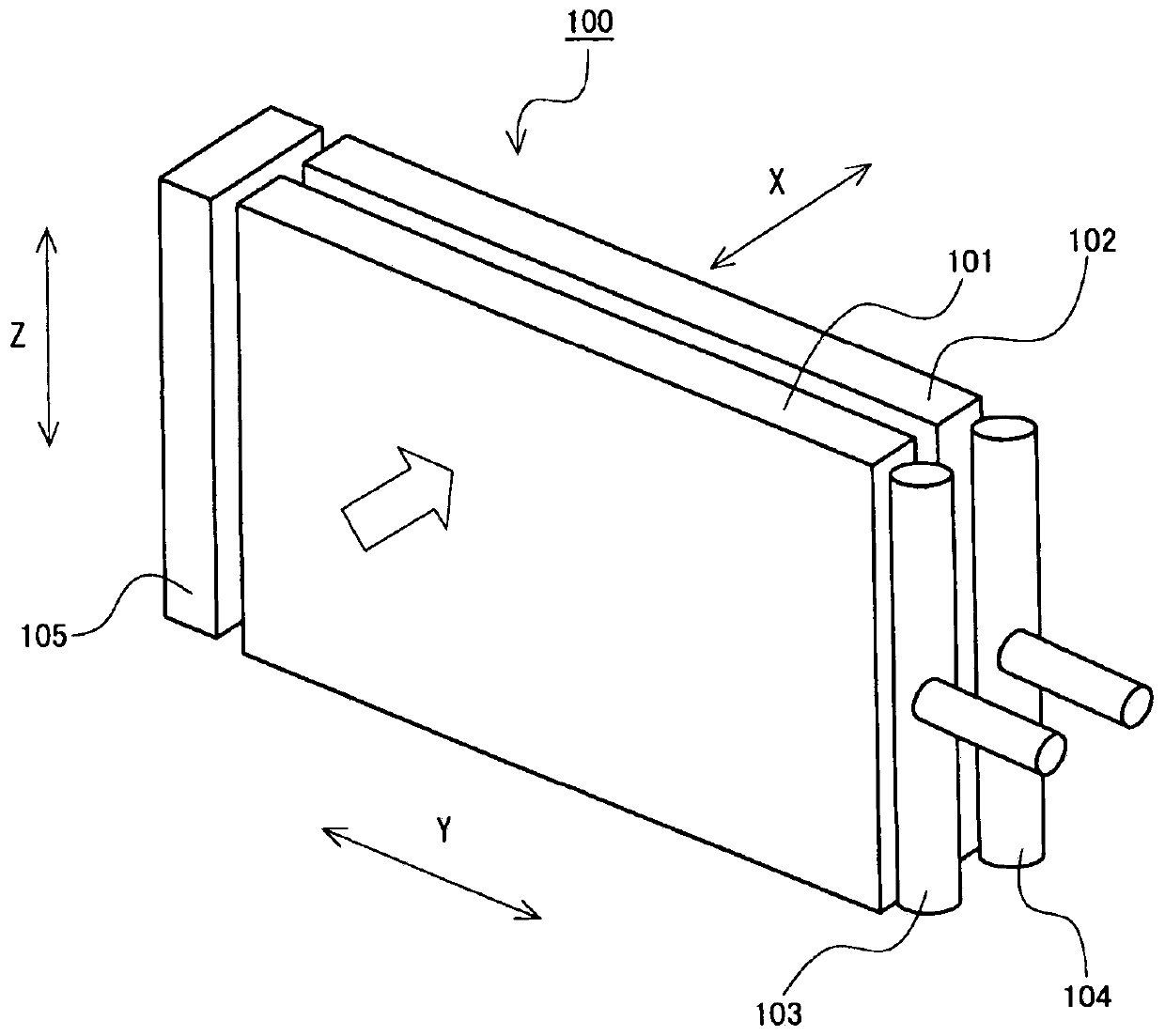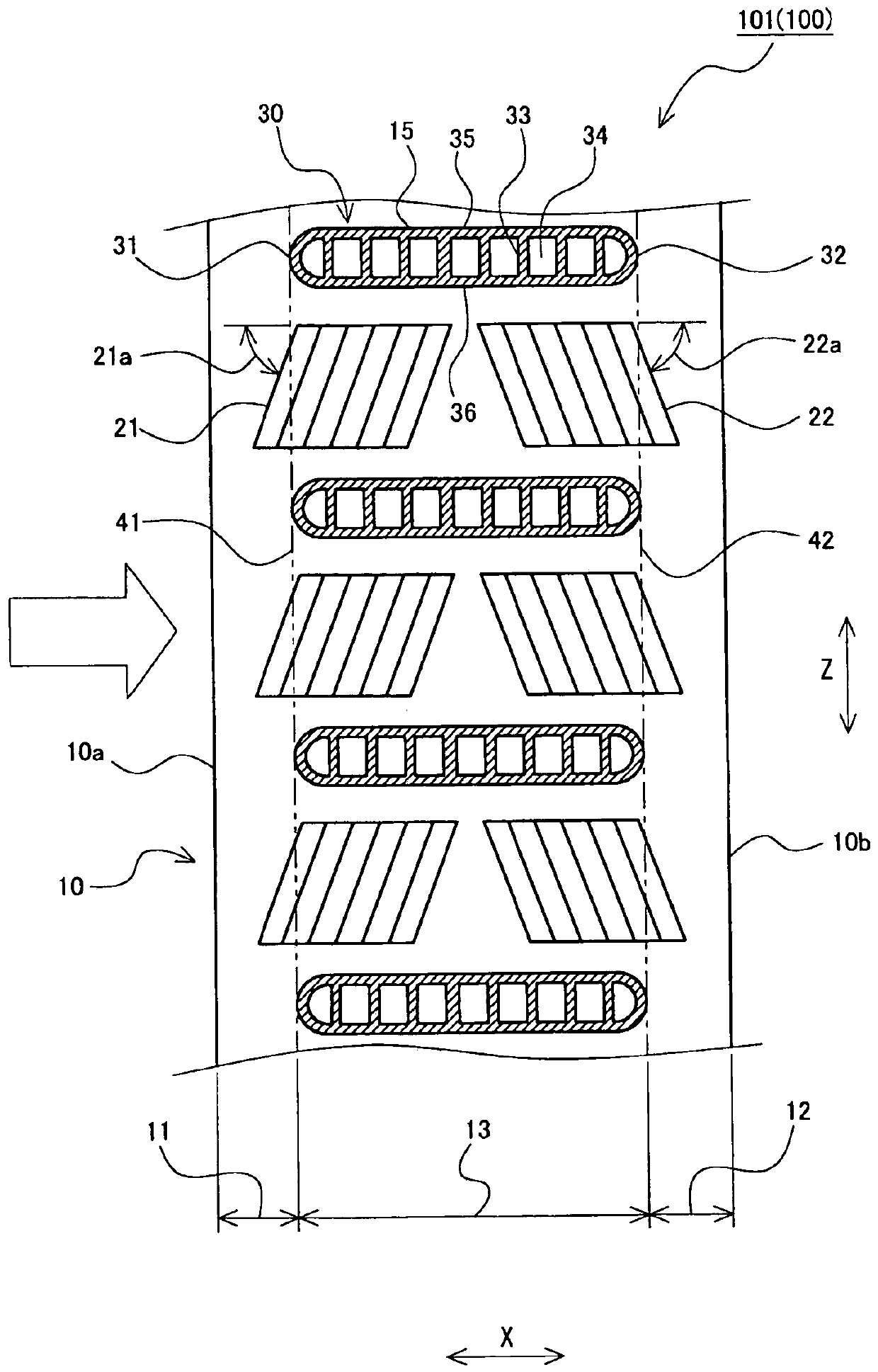Heat exchanger and refrigeration cycle device
A heat exchanger and heat transfer tube technology, applied in the field of refrigeration cycle devices, can solve the problems of reduced comfort and reduced average heating capacity, and achieve the effects of improving drainage and heat transfer performance.
- Summary
- Abstract
- Description
- Claims
- Application Information
AI Technical Summary
Problems solved by technology
Method used
Image
Examples
Embodiment approach 1
[0035] figure 1 It is a perspective view showing an example of the heat exchanger according to Embodiment 1 of the present invention. also, figure 1 The shown hollow arrows indicate the flow direction of the air supplied from the blower to the heat exchanger 100 .
[0036] As will be described later, the heat exchanger 100 according to Embodiment 1 is a fin-tube heat exchanger having fins 10 and heat transfer tubes 30 . exist figure 1 In the following figures, the horizontal direction and the direction which becomes the short-side direction (width direction) of the fin 10 are called X direction. In addition, the direction which is a horizontal direction and becomes the arrangement direction of the fins 10 which comprise the same heat exchange part (windward side heat exchanger 101 or leeward side heat exchanger 102 mentioned later) is called Y direction. In addition, the vertical direction (gravity direction) and the direction which becomes the longitudinal direction of th...
Embodiment approach 2
[0085] In Embodiment 1, the first inclination angle 21a of the first groove 21 and the second inclination angle 22a of the second groove 22 are set to be substantially the same angle. Not limited thereto, the first inclination angle 21 a of the first groove 21 and the second inclination angle 22 a of the second groove 22 may be different. In addition, in Embodiment 2, items that are not particularly described are the same as in Embodiment 1, and the same functions and configurations are described using the same reference numerals.
[0086] Figure 9 It is a vertical cross-sectional view showing a main part of a heat exchanger according to Embodiment 2 of the present invention. Should Figure 9 from with figure 2 The main part of the heat exchanger 100 of this Embodiment 2 is shown in the same viewing direction.
[0087] as in Figure 9 In the heat exchanger 100 of Embodiment 2, air is supplied from the first end portion 10 a side of the fin 10 by a blower, as indicated b...
Embodiment approach 3
[0092] In Embodiment 1 and Embodiment 2, the heat transfer tube 30 is provided so that the major axis of the cross section is along the horizontal direction (X direction). However, the installation posture of the heat transfer tube 30 is not limited to the installation posture shown in the first embodiment and the second embodiment. For example, the installation posture of the heat transfer tubes 30 of the heat exchanger 100 shown in the first and second embodiments may be set as in the third embodiment. In addition, in Embodiment 3, items that are not particularly described are the same as those in Embodiment 1 or Embodiment 2, and the same functions and configurations are described using the same reference numerals.
[0093] Figure 10 It is a vertical cross-sectional view showing a main part of a heat exchanger according to Embodiment 3 of the present invention. Should Figure 10 from with figure 2 The same viewing direction shows the main part of the heat exchanger 10...
PUM
 Login to View More
Login to View More Abstract
Description
Claims
Application Information
 Login to View More
Login to View More - R&D
- Intellectual Property
- Life Sciences
- Materials
- Tech Scout
- Unparalleled Data Quality
- Higher Quality Content
- 60% Fewer Hallucinations
Browse by: Latest US Patents, China's latest patents, Technical Efficacy Thesaurus, Application Domain, Technology Topic, Popular Technical Reports.
© 2025 PatSnap. All rights reserved.Legal|Privacy policy|Modern Slavery Act Transparency Statement|Sitemap|About US| Contact US: help@patsnap.com



